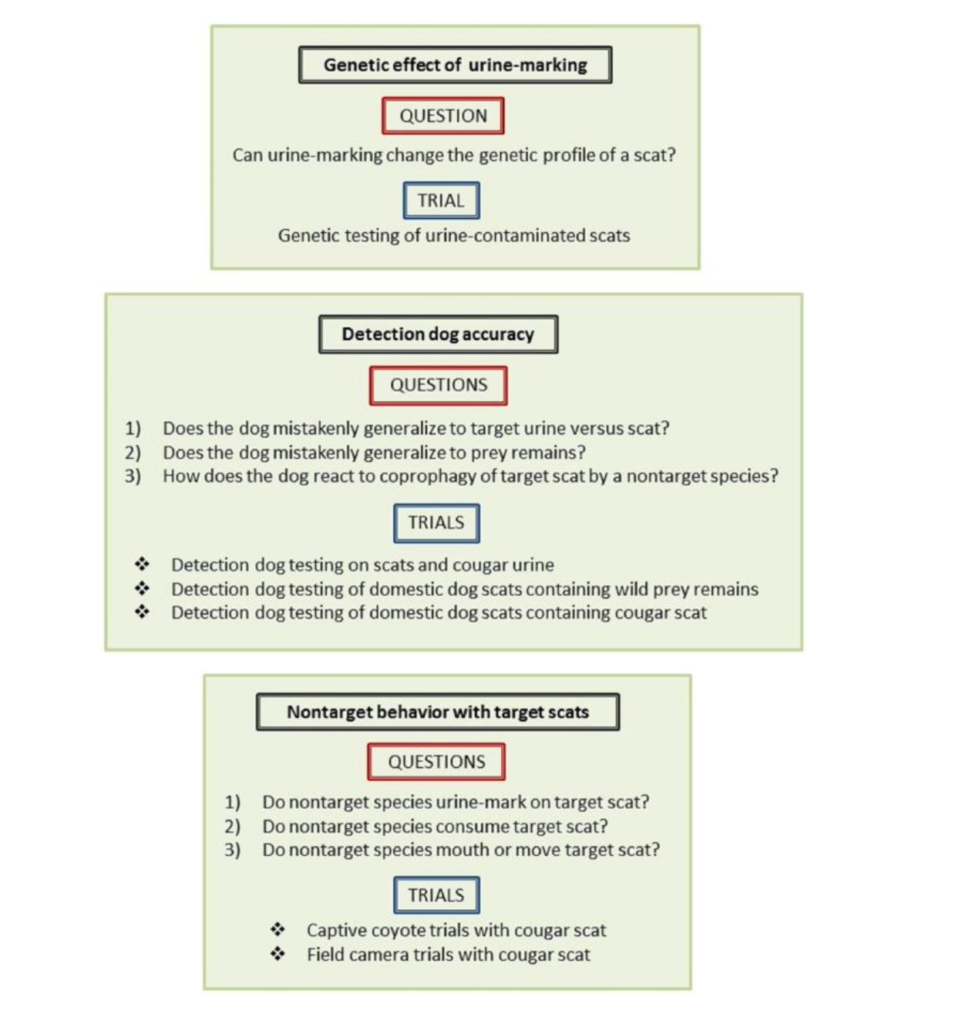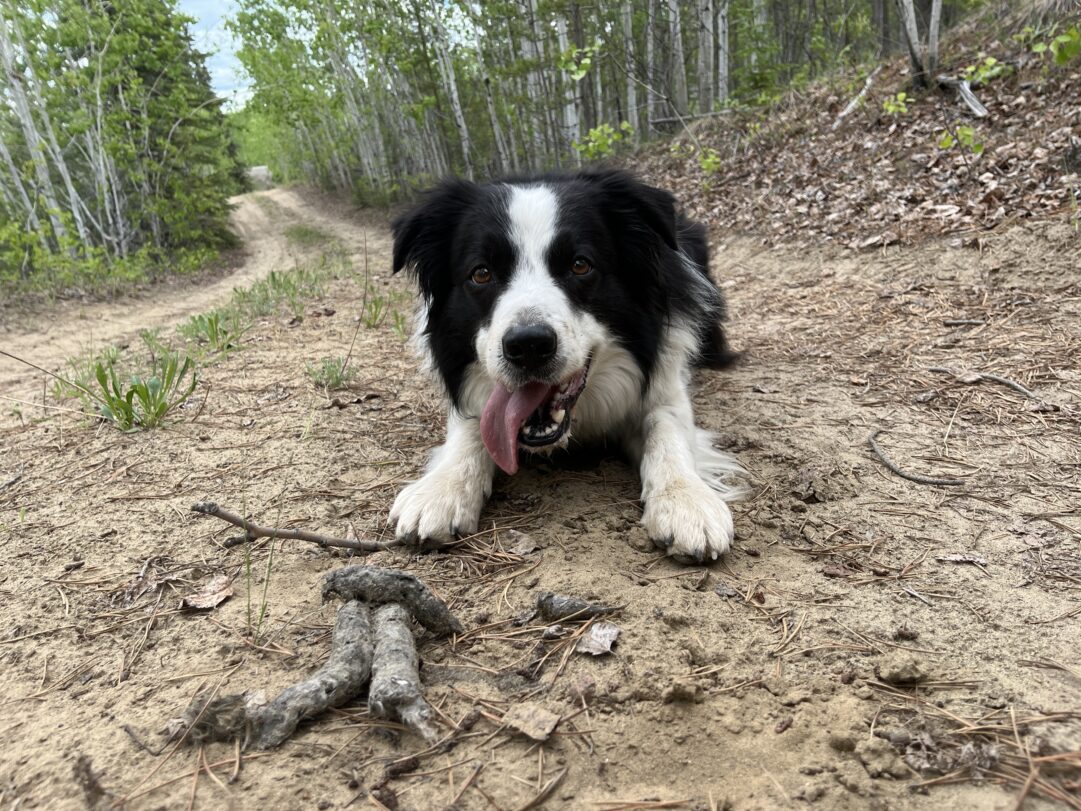This week’s science highlight concerns something many K9 Conservationists are very familiar with: scat! The study, “How Behavior of Nontarget Species Affects Perceived Accuracy of Scat Detection Dog Surveys” was published in Nature’s Scientific Reports in 2018. The authors Karen E. DeMatteo, Linsey W. Blake, Julie K. Young, and Barbara Davenport sought to investigate possible reasons for detection teams collecting nontarget species samples in the field.
As outlined in the article, detection dog searches could yield up to 44.6% nontarget species samples! Rather than assuming handler and/or dog error, DeMatteo et al. investigated three theories of how samples could be affected and ultimately collected as assumed target samples.
The Research: Questions and Methods
This study took a three-way approach to investigate sources of possible generalization in the detection dog, and possible contamination that would affect the genetic profile of the sample. Each avenue is helpfully laid out in Figure 1 from the original article:

Genetic Effect of Urine-Marking
To test the effect of urine on the genetic profiles of scat, researchers collected domestic cat scat, dried it in the sun to mimic field samples, and then dropped a typical amount of canine urine from a urine mark on
samples, where it was allowed to dry for another 72 hours. Scat and urine samples were taken from domestic animals to ensure known genetic profiles.
Detection Dog Accuracy
To test the accuracy of the detection dog, researchers ran several different surveys. The detection dog in question was a male Chesapeake Bay Retriever trained on the scat of five different carnivores. DeMatteo et al. tested three different realms of the dog’s accuracy:
- If the dog would generalize a response to target species urine
- If the dog would respond to scat from a nontarget species fed the same diet as the target species
- If the dog would respond to scat from a nontarget species that had consumed the target species’ scat.
Each session consisted of 2-3 trials with 10-14 odor stations each, and the dog was handled and rewarded as he would be in the field. When testing the dog’s accuracy with target urine, urine from captive cougars was dropped on nontarget scat as well as the ground alongside genetically confirmed wild cougar scat.
To test accuracy with nontarget species sharing the same diet with target species, roadkill dear meat and fur were fed to domestic dogs. Cougar scat was placed at the beginning, middle, and end with the domestic dog scat intermixed. Finally, to test accuracy when nontarget species consumed target species scat, researchers fed cougar scat to domestic dogs.
The dog’s detection search included cougar scat placed at the beginning, middle, and end of the search area with both domestic dog scat that had consumed cougar scat and others that had only been fed kibble.
Nontarget Behavior with Target Scats
In the last piece of this study, researchers followed nontarget species behavior with target species’ scat. There were two trials in this study: one with captive coyotes and another with trail cameras. The captive coyotes had cougar scat placed in their enclosures, where trail cameras monitored their behavior.
The cougar scat and the coyotes’ normal diet each contained a different color of glitter to examine the composition of their scat later. In the field camera trials, a single cougar scat was placed in the center of three trail cameras at 8 different sites and monitored for 14 days.
The Results
Genetic Effect of Urine Marking
The results of this survey were simple: all of the domestic cat scat samples tested with the genetic profile of a domestic dog.
Detection Dog Accuracy
For each trial, the detection dog was recorded to have a strong positive response (classified as a trained response to indicate the target), a negative response (investigation of the sample but no indication and moved on), and no response. In the test assessing if the dog generalized target species scat to target species urine, the dog had a negative response to nontarget species scat independent of target urine. The dog did, however, show a strong positive response to target scat, also independent of the urine. Urine not on scat had no response.
The next trials investigated the dog’s accuracy with nontarget species that consumed a similar diet as the target species. This trial was simple for the detection dog; he had a negative response to all the domestic dog scat, and a strong positive reaction to cougar scat.
The final trials testing the dog’s accuracy are where the results get interesting. The dog had a strong positive response to cougar scat, as expected. He also had a negative response to kibble-fed domestic dog scat, which we would also expect. However, domestic dog scat of dogs that consumed cougar scat altered this pattern. The scat had a noticeably different appearance and smell rather than kibble-fed scat. The dog had a strong positive response to these samples, despite them testing genetically as domestic dog scat.
Nontarget Behavior with Target Scats
The coyote trials confirmed nontarget species will interact with target scat. The coyotes were seen consuming, rolling in, and marking the target scat. When the coyote scat was searched by the detection dog, the scat without access to cougar scat received a negative response. However, scats that were primarily cougar scat and other mixtures of “normal” scat and cougar scat caused a strong positive response.
The trail cameras also provided support for nontarget species interacting with target scat. Observations from the camera showed many different species interacting with the scat in various ways.
So… what does this all mean?
Essentially, now we know many different factors can cause an alert for a nontarget sample. Not all incorrectly collected samples fall only to handler and/or dog error. Behavior from nontarget species – marking, consumption, etc.- can cause an olfactory response in a detection dog that just does not line up with the genetic profile. Moreso, these “imposter” samples can look like target scat from a handler’s point of view. This research suggests the need for handlers and detection dog organizations to consider stricter collection procedures, such as only collecting fresh samples or simply a deeper evaluation of possible interactions with nontarget species in the area.
As with all research, this study had its limitations. The biggest limitation is the sample size of only one dog with a handful of trials. More dogs with more trials would expand the data observed within this study and create stronger correlations. Much of the samples used in this study came from domestic or captive animals. Expanding to more wild samples and conditions that are closer to field conditions would also bolster this data.
Overall, this study brings interesting information into the realm of field samples and the accuracy of detection dogs. As you work your dog next, consider what could be interfering with your search, especially the interaction of nontarget species with your target. There might be more factors than originally meets the eye!
Source: DeMatteo, K. E., Blake, L. W., Young, J. K., & Davenport, B. (2018). How Behavior of Nontarget Species Affects Perceived Accuracy of Scat Detection Dog Surveys. Scientific reports, 8(1), 13830. https://doi.org/10.1038/s41598-018-32244-1
 Donate
Donate

